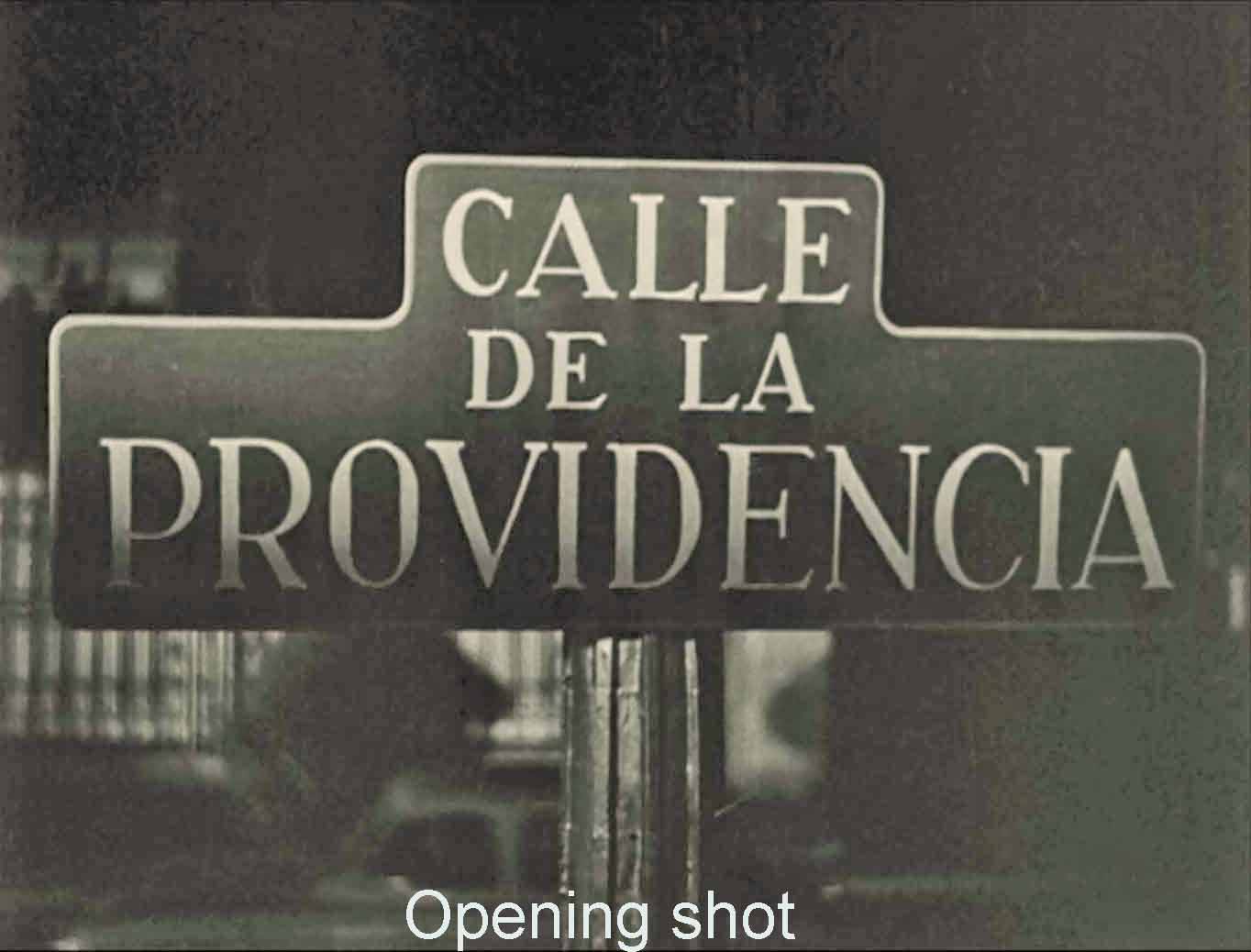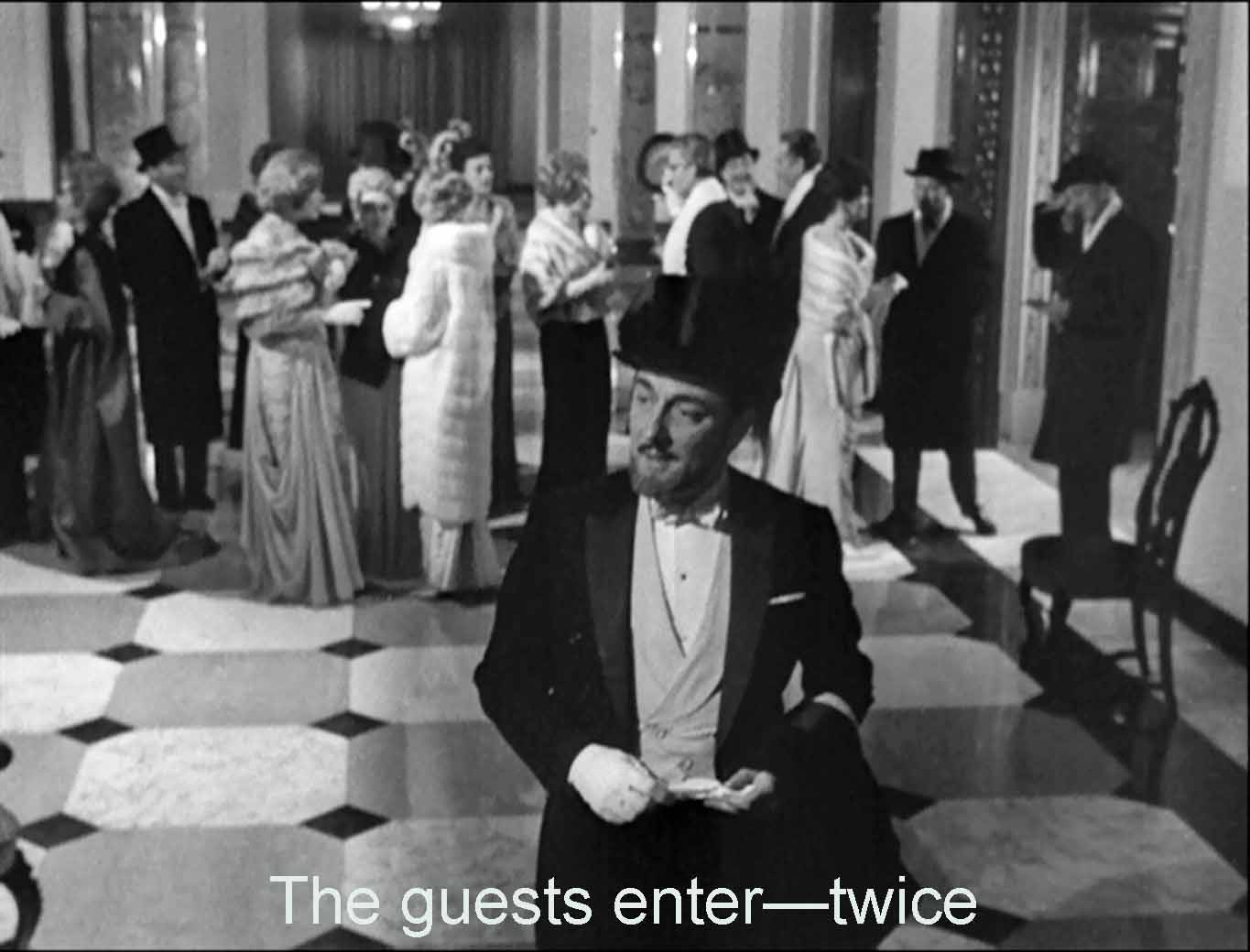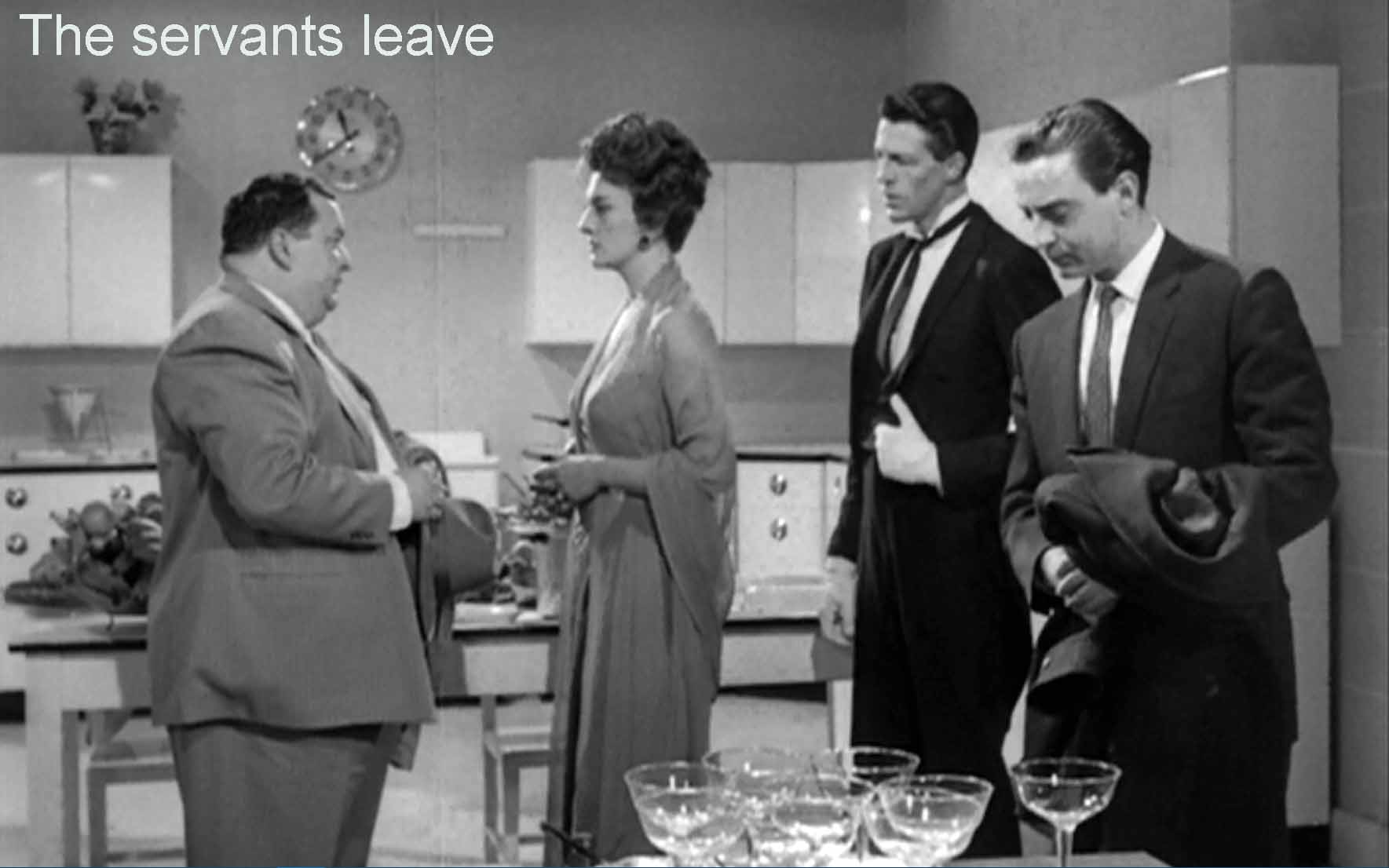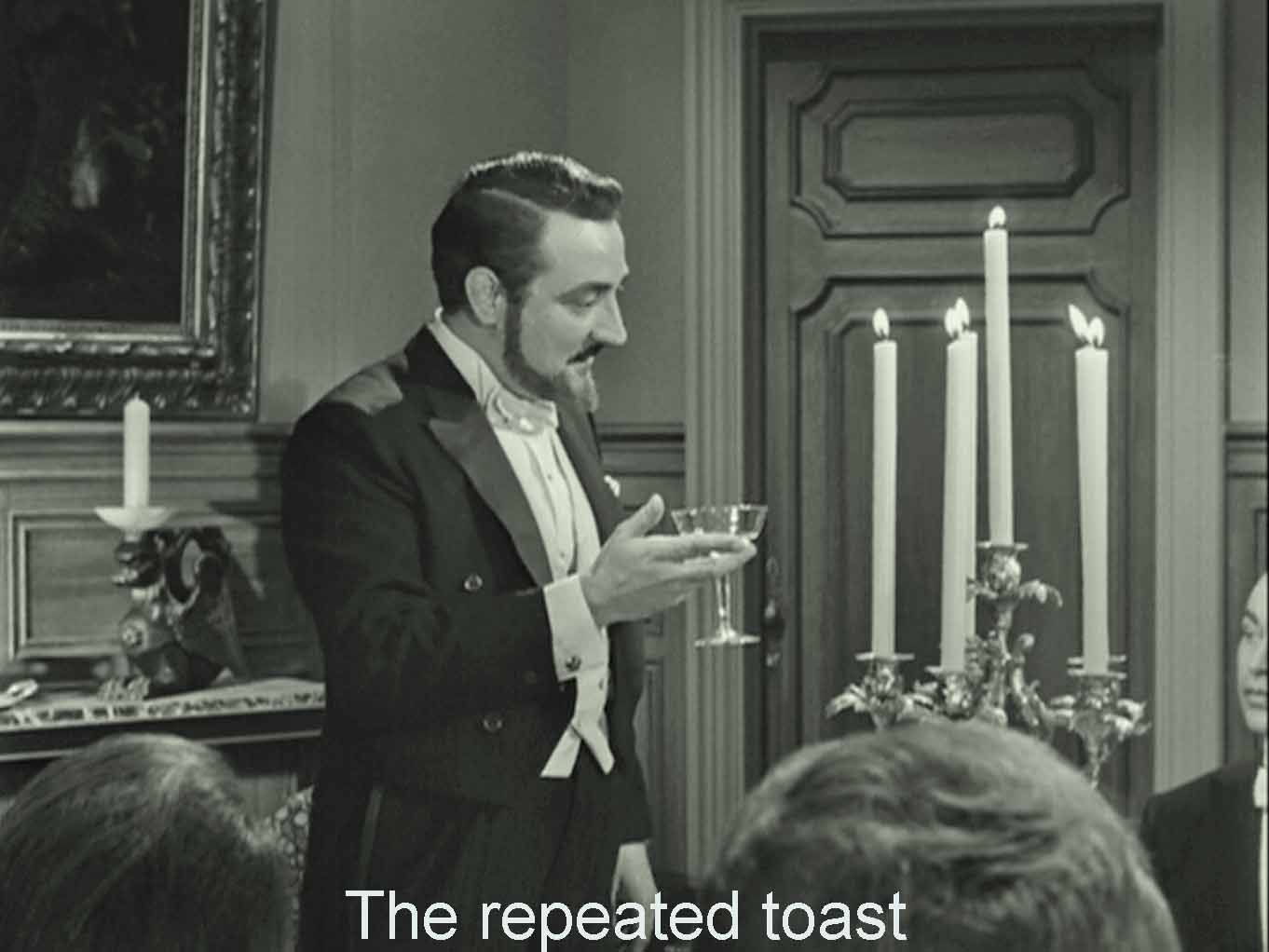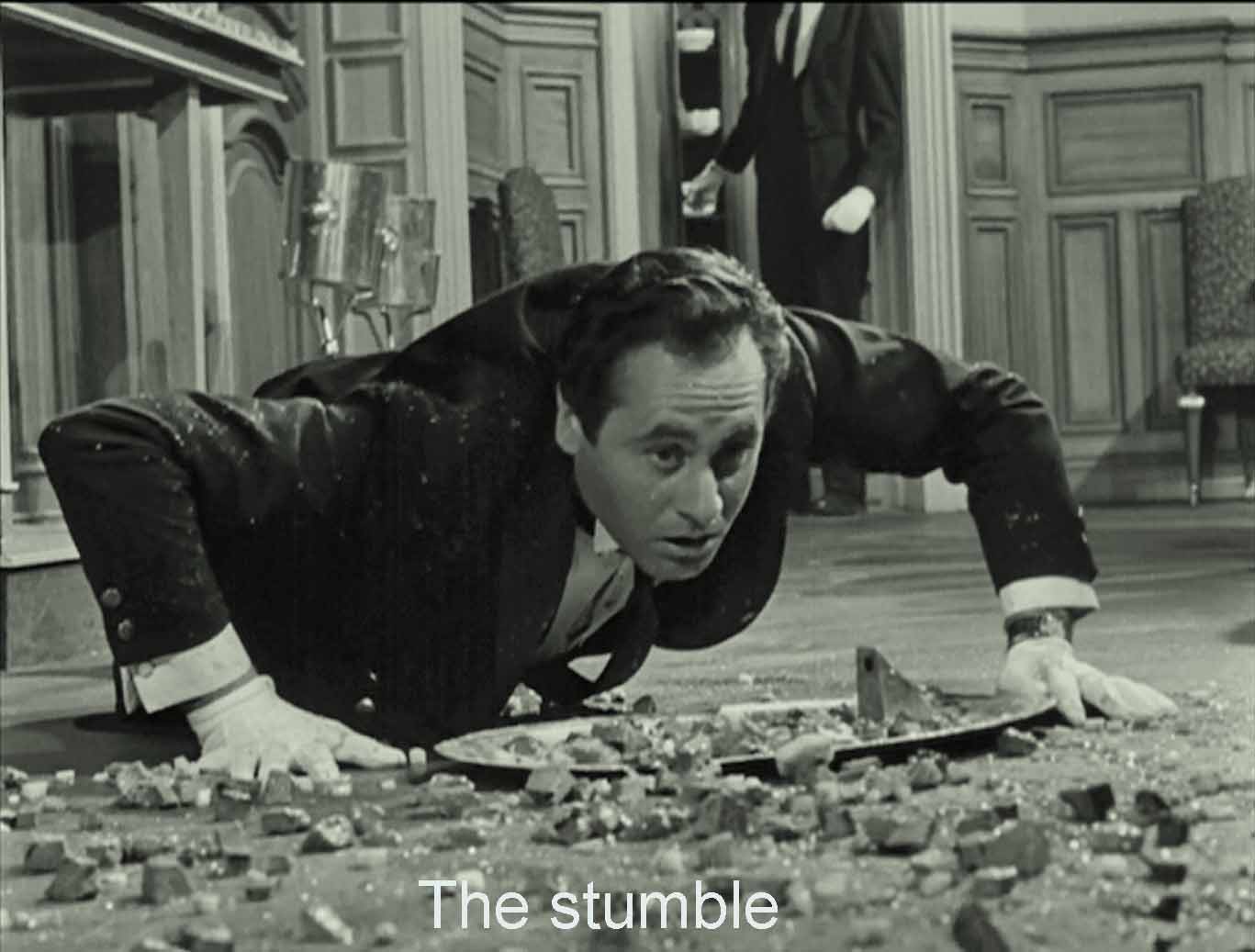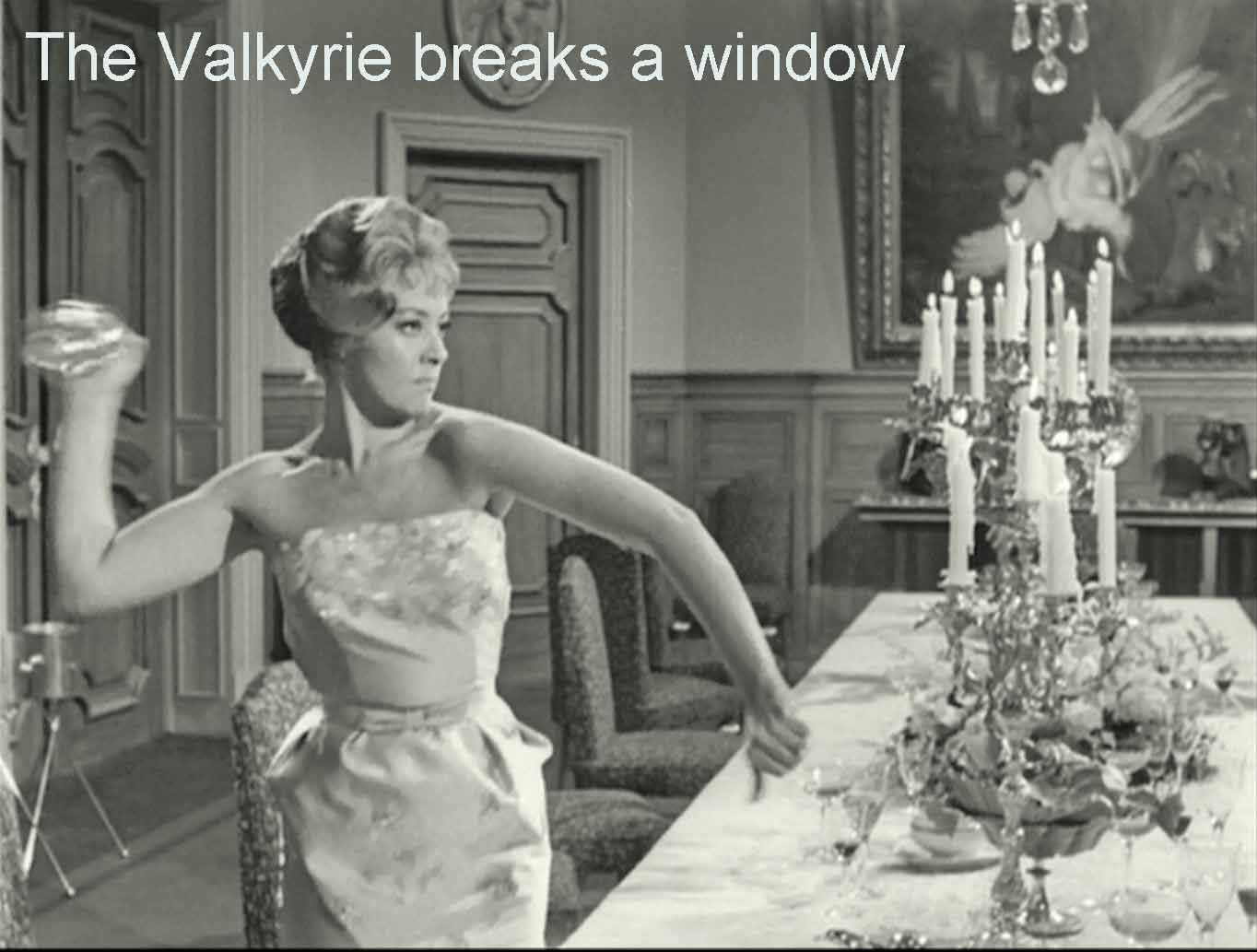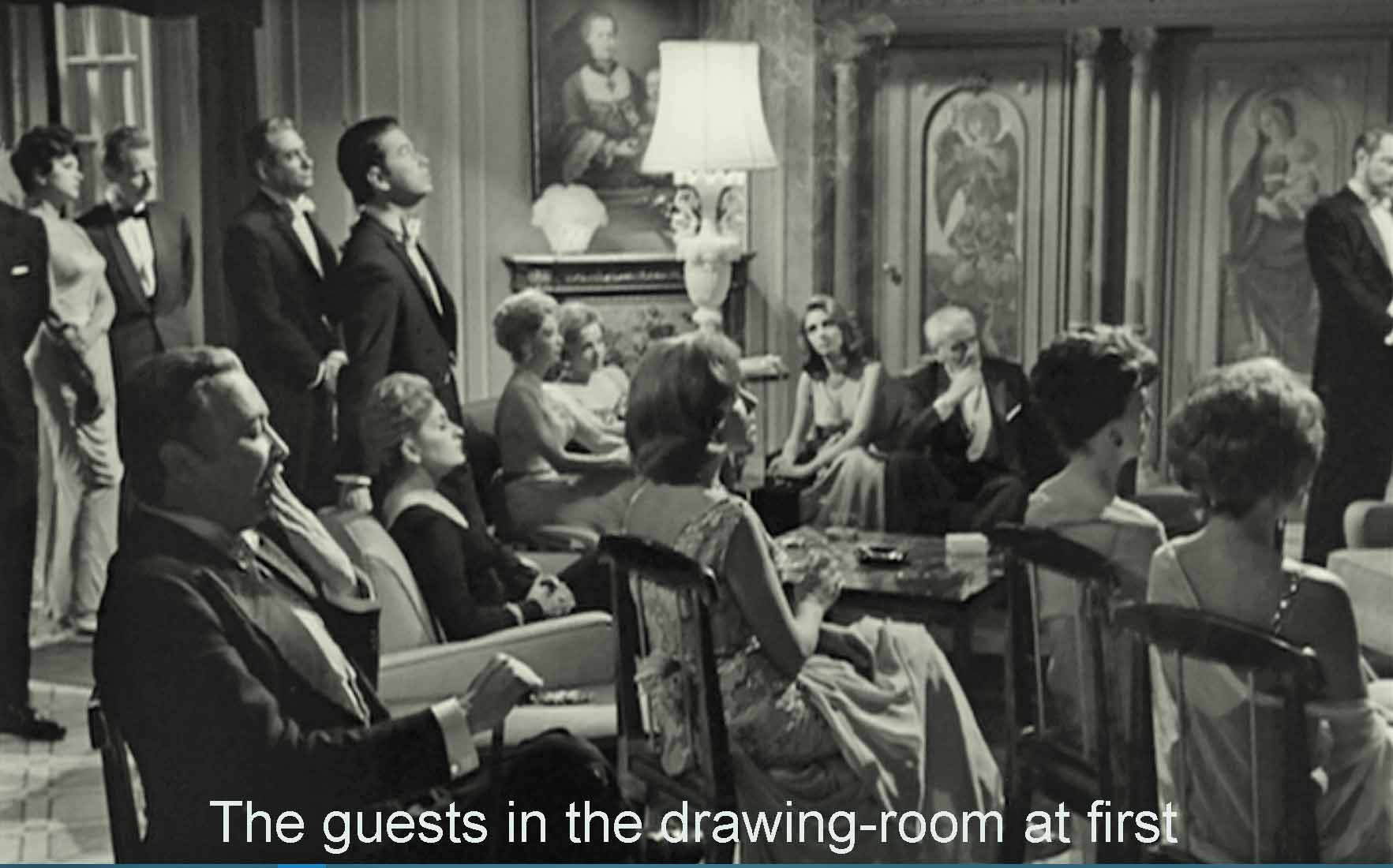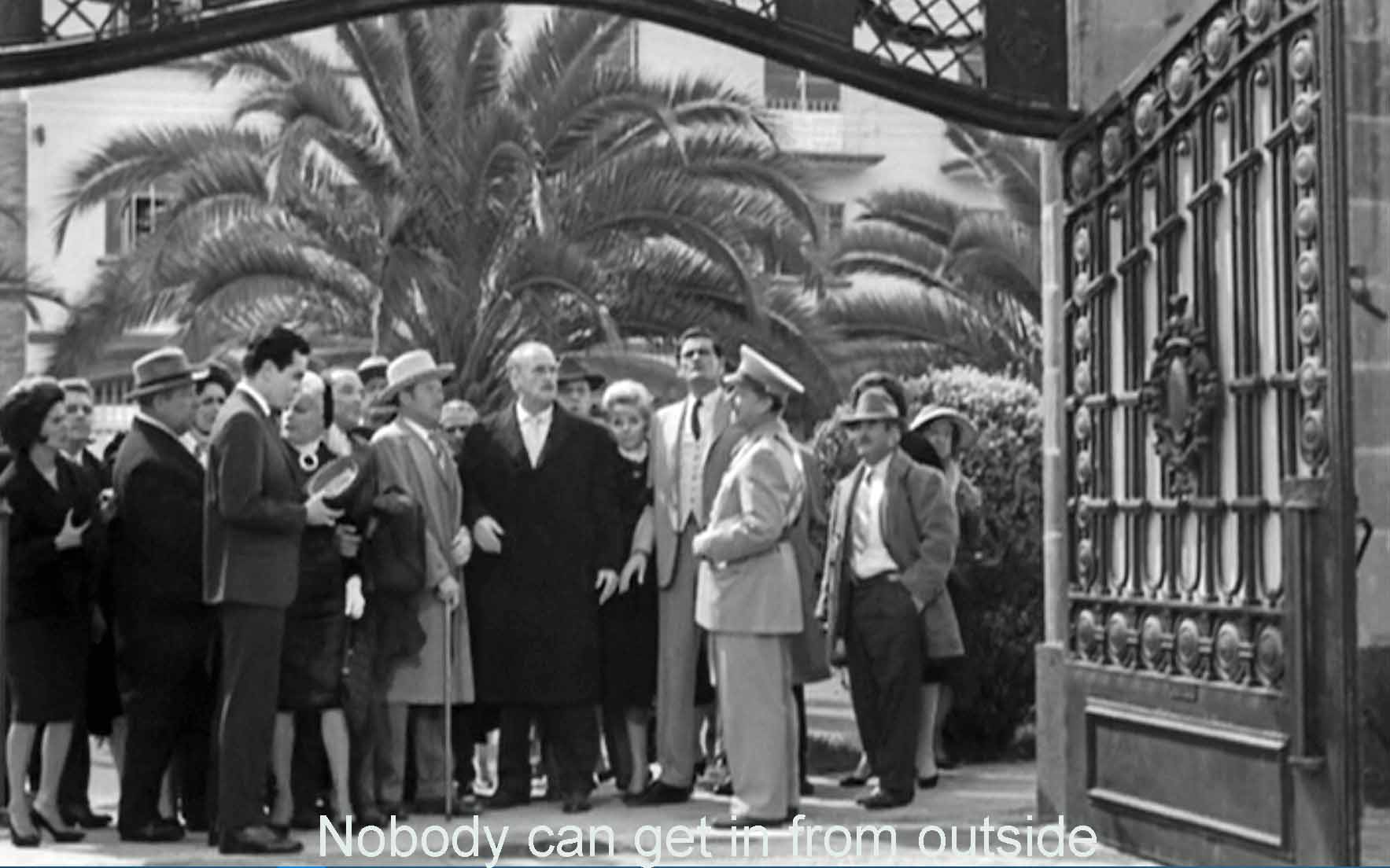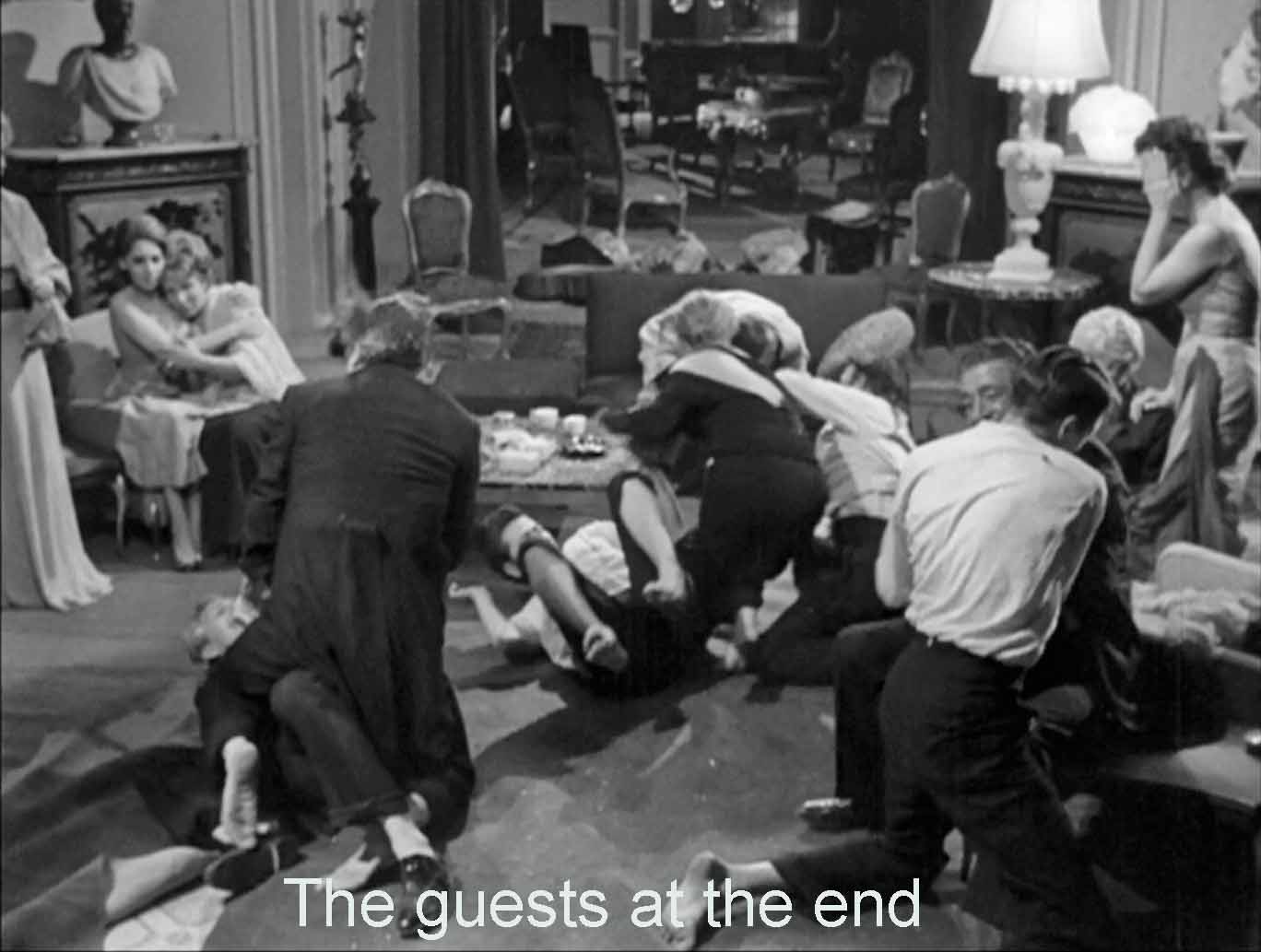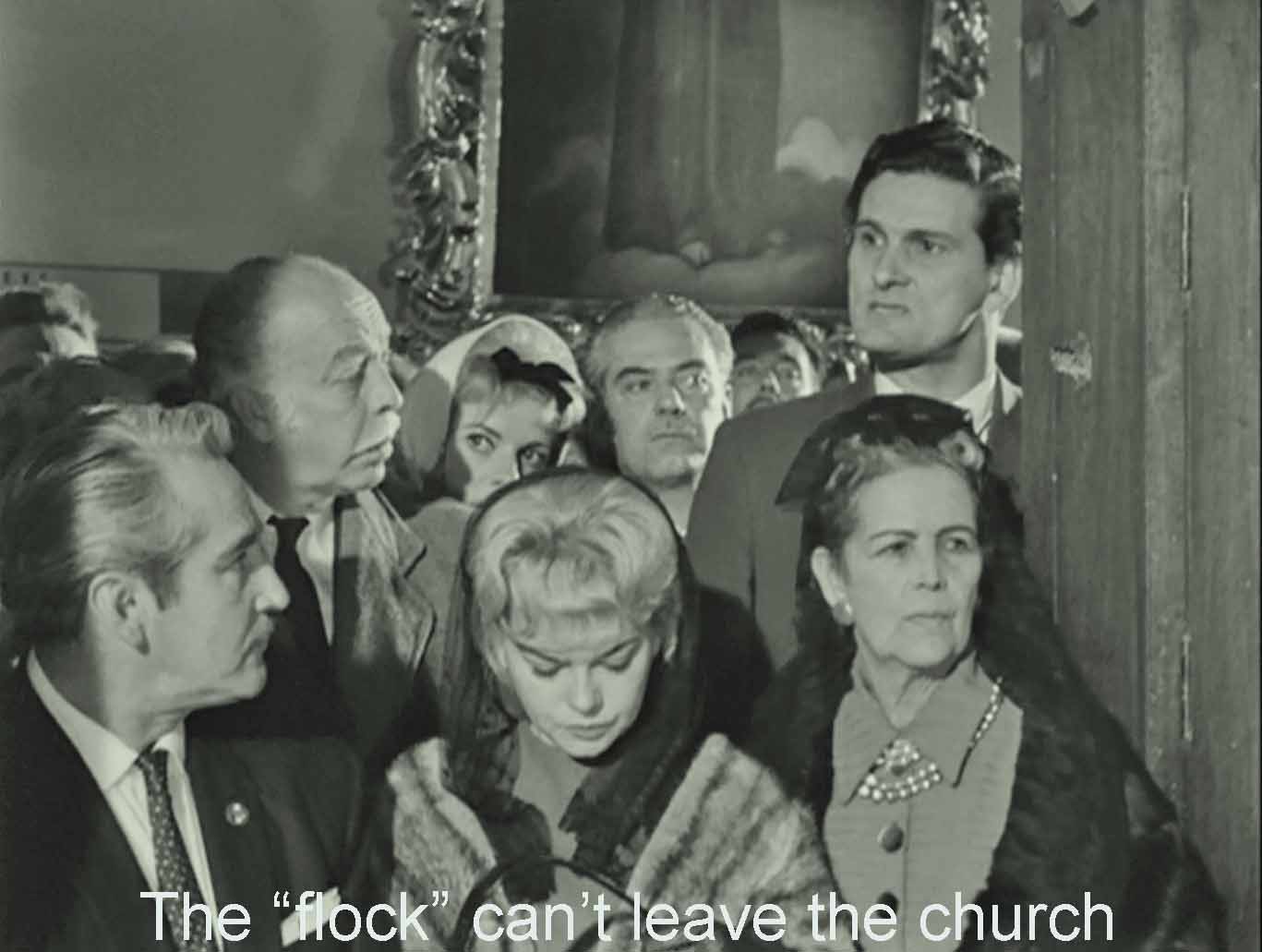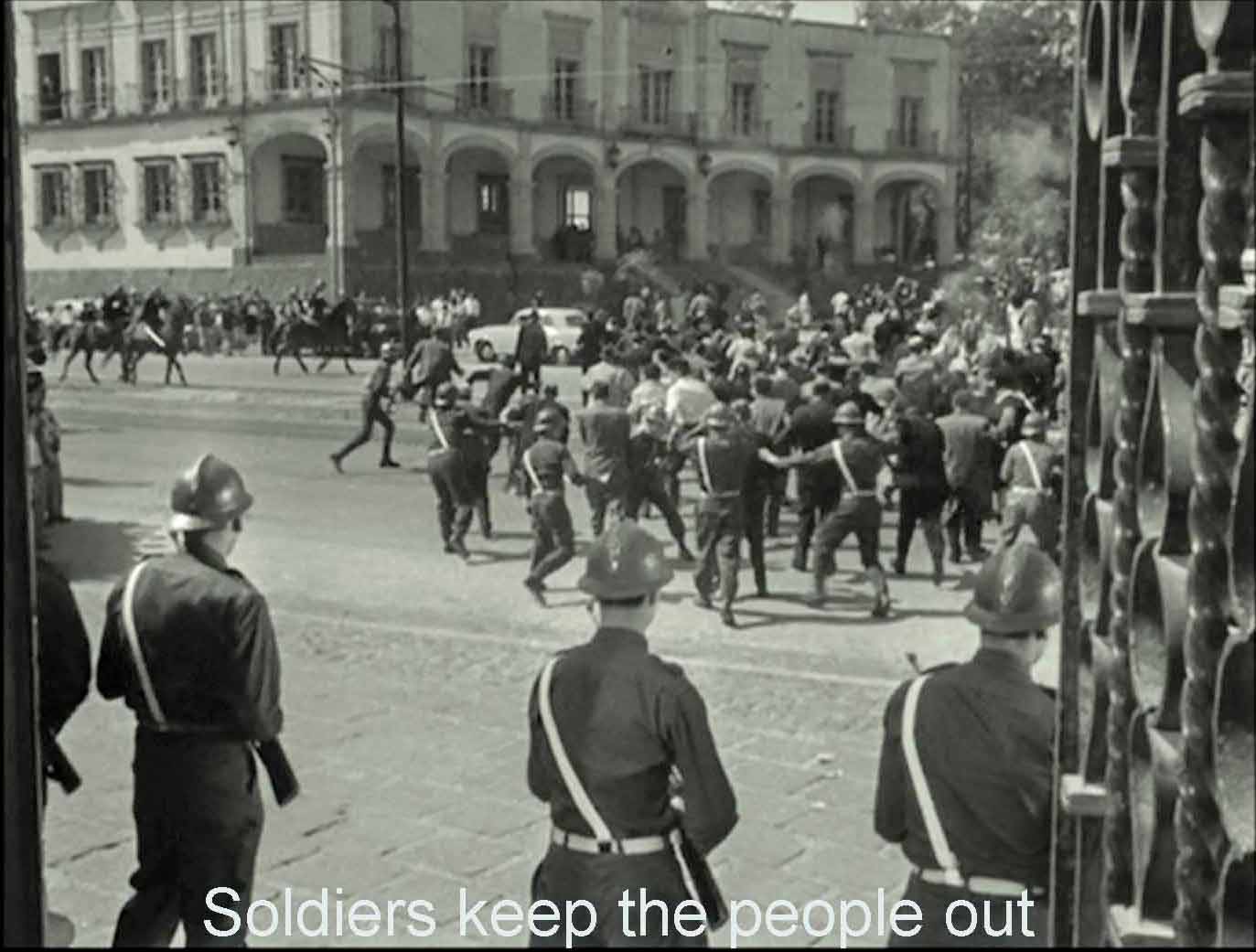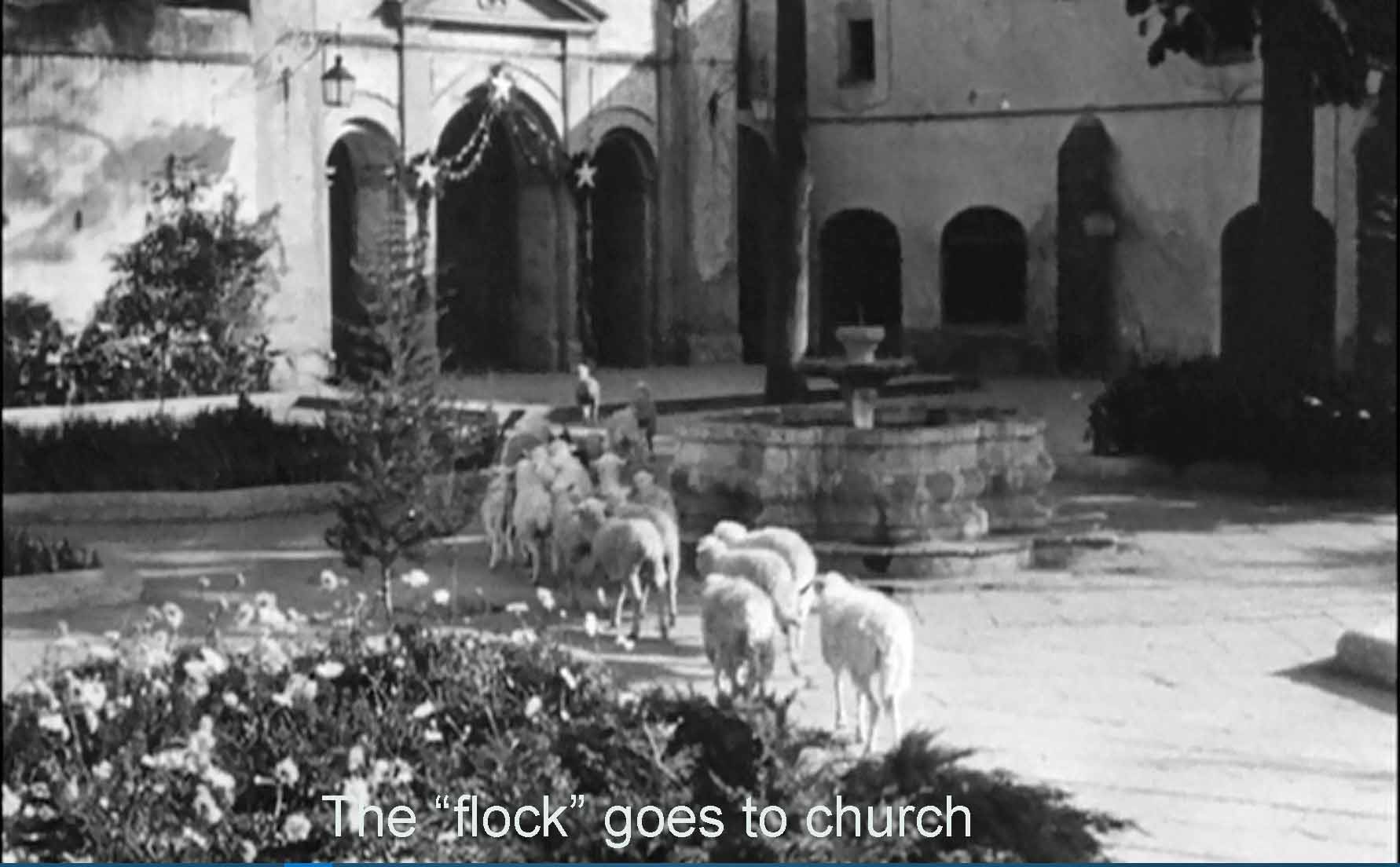The Exterminating Angel or El ángel exterminador, Luis Buñuel’s 1962 film, has baffled viewers and critics for decades. A group of upper-class guests attend a post-opera dinner party. Dinner over, they repair to the drawing-room. Then they can't leave! These people are confined for weeks in that room, because they cannot walk through an open doorway to freedom. Why!! During those weeks their proper bourgeois behavior breaks down utterly into filth, gratuitous cruelty, and murderous violence.
So far as I have been able to find out, Buñuel’s reviewers and critics over the years cannot explain why these upper-class people can’t leave this drawing-room. Again and again critics throw up their hands, but feel compelled to offer a straightforward reading. They say the film illustrates the bestiality and savagery waiting to erupt inside our politically oppressive, civilized (upper-class?) behavior, the “collapse of bourgeois ‘niceness’” (J. Hoberman). Fair enough. But I would like to suggest an alternative, a core idea that might let us see The Exterminating Angel more fully as a unified work of art.
For me, the art of seeing a movie involves understanding how all its various details can be seen as informing an integrated artistic whole. These one-percenters being confined in a drawing-room and finally getting out forms the most striking part, but only the middle of the film. There are details in Buñuel’s film beyond the confinement that, for me, a sociopolitical reading doesn’t take into account. Why the many repetitions in the movie? Buñuel said there were twenty, some more noticeable than others. The guests enter the house twice. The host offers the same toast twice. Why does repeating a piano performance by one of the guests release them? Obviously repetition is an important aspect of this film. The guests put up obviously phony reasons for not being able to leave, while the servants put up equally phony reasons for leaving. What do these things have to do with social and political satire?
Let me take a detour. Buñuel and the other surrealists were famously interested in Freud and psychoanalysis because of the importance he put on dreams and the unconscious. Surely what Buñuel demonstrates in the drawing-room is “regression.” That would be the psychoanalysts’ term for “the collapse of bourgeois niceness,” the loss of normal adult inhibitions.
We can certainly call what happens “regression,” but I think another psychoanalytic concept is at work in that room. Wiederholungszwang, is the delicious German mouthful for what Freud and later psychoanalysts call in English, the “repetition compulsion” or the “compulsion to repeat.” “There I go again.” “I’m always doing that.” “I make the same mistake over and over.” We all know the phenomenon much too well.
The compulsion to repeat underlies what we think of as character or, the term I prefer, personal style, like one’s handwriting or prose style. “That’s just like Norm.” “He always reacts that way.” “She always picks the wrong kind of guy.” We could think of our overall character or personal style as the aggregate of our various compulsions to repeat.
So what does this have to do with Buñuel’s famously obscure film? Like any good surrealist, Buñuel represents the psychological fact in physical terms. Being one’s repetitive self is like being boxed in. You are in a cage, the cage of your character—or, in this film, a drawing-room you can’t get out of. Notice that the characters’ confinement is mental, not physical. They go up to the exit doorway and make excuses for not being able to go through. They are just like us. When our character compels us to repeat, we justify what we are doing. “There I go again”—but I go; I don’t not-go. I repeat and find reasons to justify repeating.
In their long confinement in that drawing-room these suffering bourgeois demonstrate their several personal styles over and over, not just in their civilized behavior but in their bestiality. The grumpy Sergio Russell (Antonio Bravo) was grumpy in the dining-room; he continues his grumpiness in the confinement. Dr. Carlos Conde (Augusto Benedico) urges rationality again and again, while the host Edmundo Nóbile (Enrique Ramba) enacts the noble host again and again, even to the point of offering to kill himself to break the spell. Ana Maynar (Nadia Haro Oliva) demonstrates her superstitious nature with chicken feet in her purse and a ceremony from the Kabbalah. The amorous Beatriz (Ofelia Montesco) finds a place for her and her lover. They die together in a familiar metaphor for orgasm. The weakling younger brother Francisco Avila (Xavier Loyá) demonstrates his weakness over and over, and his mothering sister Juana Avila (Ofelia Guilmáin) shows over and over how he got that way. The aggressive Raúl (Tito Junco) picks fights. The religious Leonora (Bertha Moss) longs for a trip to Lourdes and a washable plastic Virgin. All the characters lament the loss of their customary ablutions. In short, the middle of the film consists of all these characters demonstrating the repetitiveness of their characters—and ours. Their increasing bestiality is, in psychoanalytic terms, a regression, but even regressed they necessarily act out their personal styles.
Buñuel takes his physical representation of Freudian ideas one step further in the releasing of these imprisoned characters. Some of the ways psychotherapy works are through “regression” and “transference.” Lying on the couch, the patient regresses toward childhood and childish patterns, as these guests do. Then follows “transference.” (Indeed the word occurs in the film when the doctor explains quite correctly to his amorous patient Leonora that her passionate desire for him is “transference.”) For instance, a patient, having fought with her parents all through childhood, now fights with another authority-figure, the therapist. She has transferred her feelings toward her parents to the therapist. By becoming conscious of this trait in the safe environment of the consulting room, the patient can perhaps replace an unconscious compulsion to repeat her squabbling with a conscious decision to repeat or not to repeat it. And the hope is that the patient can exercise this conscious control in life, not just with the therapist.
Buñuel embodies in the film this therapeutic recovery from helpless, unconscious repetition to conscious intention quite literally when he releases the party guests from their confinement. “Valkyrie,” Leticia (Silvia Pinal) has the pianist Blanca (Patricia de Morelos) repeat her playing of the “Toccata in A,” a famous piece by the eighteenth-century Italian composer Paradisi. (Surely performing a memorized piece is as repetitious an act as can be, and the name Paradisi makes a nice contrast to the hell they’re in.) But then Leticia has the guests stand in the same places and deliberately repeat the very comments they made after this same music weeks before. They don’t just repeat, they consciously repeat—and suddenly they are freed! Buñuel has his imprisoned bourgeois enact a miniature psychotherapy.
This suggestion that Buñuel informed The Exterminating Angel with psychoanalytic ideas may explain the middle of the movie, the confinement, but much happens outside that core.
Buñuel introduced the ideas of repetition and the expected and unexpected early on in the dinner party itself. The host, Edmundo Nobile makes a gracious toast to Silvia (Rosa Elena Durgel) who provided the opera they have just seen. The guests all graciously echo the toast. Then Nobile makes the very same toast again but this time, to his puzzlement, the guests ignore him—the predictable has become unpredictable. The hostess Lucia (Lucy Gallardo) tells her guests she is going to vary the usual order of courses with a Maltese dish. The waiter comes in with the platter but stumbles, falls, and spills the food all over. The guests laugh delightedly because it is “quite unexpected,” but one woman comments that “Lucia has a style all her own,” and the other guests praise the fall as though this were all her characteristic plan. Buñuel is asking us to notice the difference between what is accidental and unpredictable and what is characteristic and predictable.
Another unpredictable incident: The guests have all gone into the drawing-room leaving Silvia, the “Valkyrie,” alone at the table. She picks up an ashtray and throws it through a plate-glass window noisily shattering it. Surely an unexpected event. One guest, hearing the crash, says simply, “Some Jew passing by,” as if it were just part of the predictable religious and class conflicts in this society. But the aggressive Raúl says, “No, it’s the Valkyrie”—presumably he knows the unpredictability of this woman. Or is her violence part of her character, and that is why she is called the Valkyrie? The point is that Buñuel is calling our attention again and again to repetition and what is predictable and unpredictable in a person’s personal style.
Why the title of the film? By “why,” I mean how do I see the title contributing to what seems to me the aesthetic unity of the film around ideas of repetition, compulsive repetition, and character. The Exterminating Angel: There are several references to an “angel of death” in the Bible. An undocumented Wikipedia entry, though, refers the title to “The Society of the Exterminating Angel.” This was “a Catholic group in Spain that was created to kill Spanish liberals, founded in 1821.” Buñuel could well have known of such a group—and despised it. To me, it represents the repeated savagery that emerges in the core of the film from beneath the bourgeois and religious propriety. Or it could represent the savagery that often crops up in the Bible.
The film begins and ends with a church—why? For the fiercely leftist and agnostic Buñuel the Spanish Catholic church must have represented the quintessence of the irrational and unjust compulsions imposed by Franco’s Spain. Surely there is nothing so repetitive as the rituals of the Catholic or any church. So too are the lovingly photographed church bells with their one note, “character” taken to its narrowest.
At the end of the film, the guests from the middle of the film and a congregation and the priests enact the repetitive rituals of Catholicism. Then, as if to underscore the meaning of the repetition, neither priests nor worshipers can leave the church. They are trapped as in the drawing-room, but now we are seeing a whole society, not just some dinner guests, confined in its character, its repetitive rituals and, to Buñuel, superstitious rituals. Outside, soldiers drive off citizens trying to enter the church as earlier the police stood between people outside and people inside the mansion. This bourgeois, religious character will persist and be sustained at all costs. And in the final shot, a flock of sheep enter the church, surely an ironic comment on the mindlessness of the religious rituals and the class structure so savagely enforced. Is this a “flock” seeking the Good Shepherd? Or is this a society of sheep blindly following their leader (Franco?) into endless, meaningless, and cruel repetitions? Or are these sacrificial victims like the sheep in the mansion?
The opening shot of the film tells us it will take place on Calle de la Providencia: “Providence Street”? Why? That’s in the title of the unpublished play that Buñuel worked from, but why did he keep it? I think Buñuel knew that “providence” refers to the Christian doctrine that God continuously maintains the universe and its natural order, including, presumably, the unjust class structure on which this film and the persistent characters of these rich partiers depend. The injustice is embodied in the luxurious house and many servants these hauts bourgeois enjoy. And Buñuel might have wanted to say at the outset that events are determined not by God, not by the characters, but by the god-like director.
Why the bear and the three sheep? Evidently the hostess Lucia planned some sort of show for her guests. Was she going to have the bear attack the sheep? We get a class structure from the outset not only with the servants but with these animals. These plutocrats have the same predatory relationship to their servants as the bear to the sheep. And indeed these moneyed guests finally do eat the sheep (using a cello as firewood in the process—so much for the arts). Surely we must take the reference to Providence Street as ironic since the normal and unjust order of things, supposedly maintained by God, falls apart in this film.
Buñuel starts the theme of repetition five minutes into the film. The guests enter the mansion in top hats and evening gowns, having been to the opera. Then Buñuel has them enter again in virtually the same shot, but with a slightly higher camera angle, one of the famously baffling episodes in the film. (But this is a film about repetition!) There are two unrelated characters caught in this repetition, two female servants trying to sneak out the front door without being seen by their employers. And they have to improvise in response to these rich people’s repeated appearances at the front door. One repetition, the rich people’s, is imagined; one, the servants’, is real.
